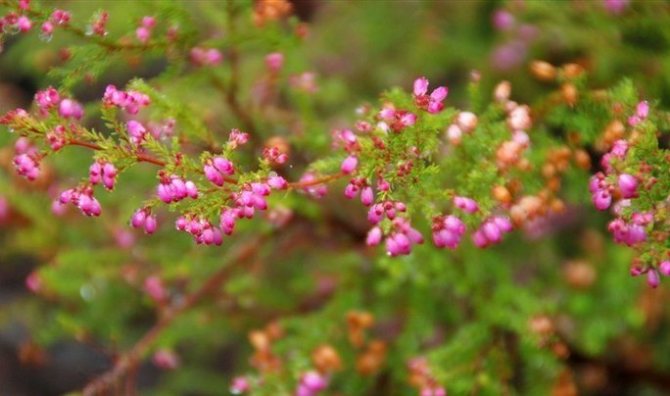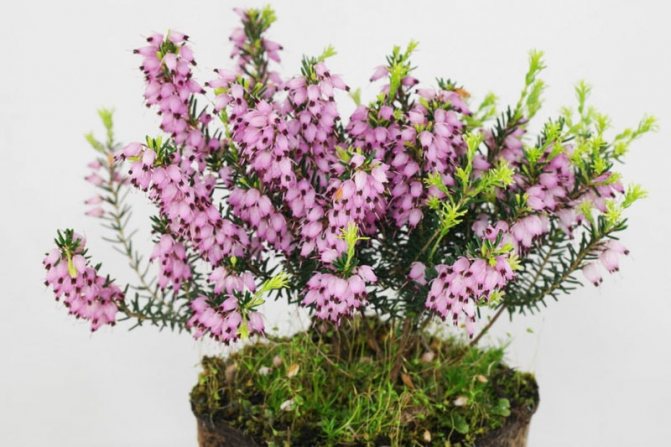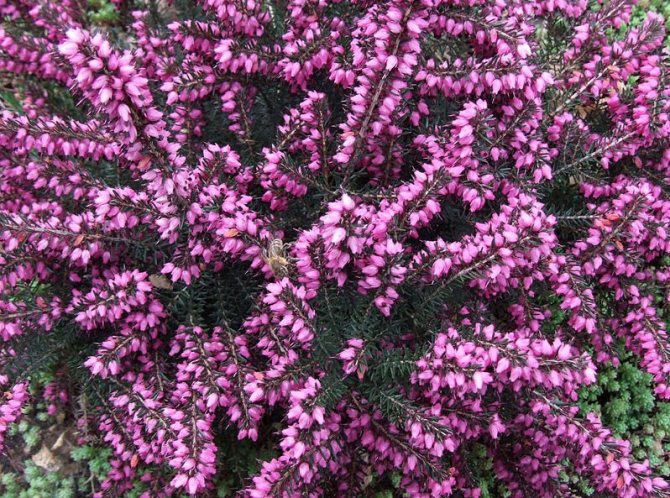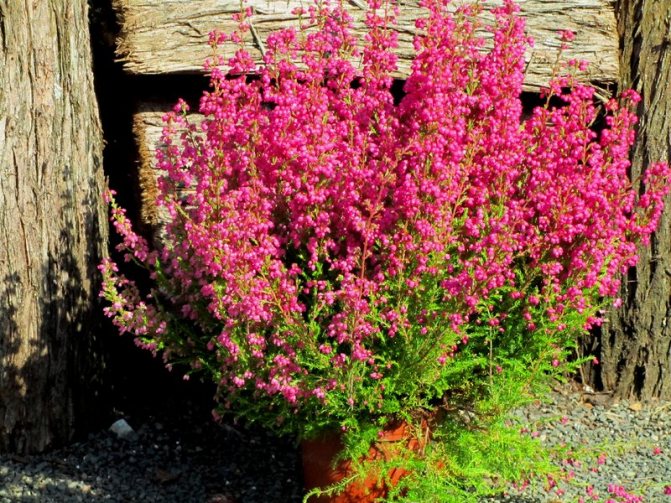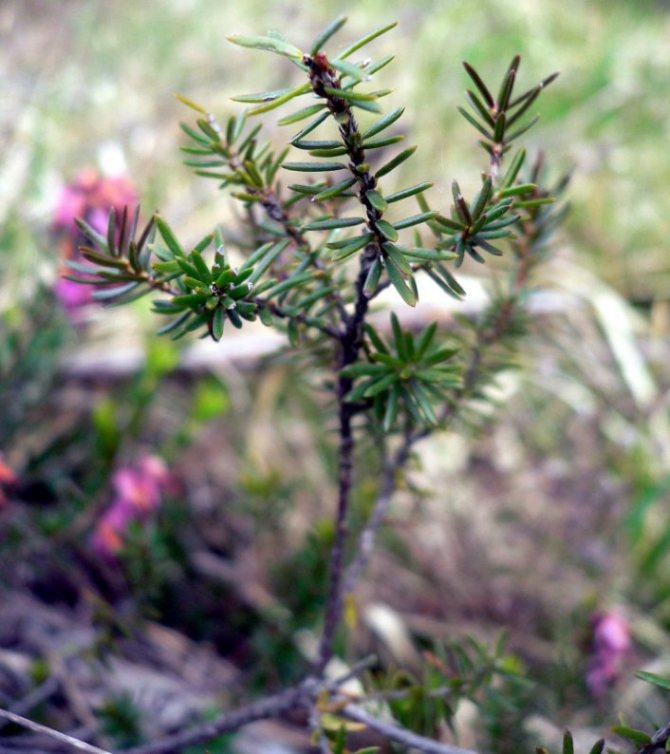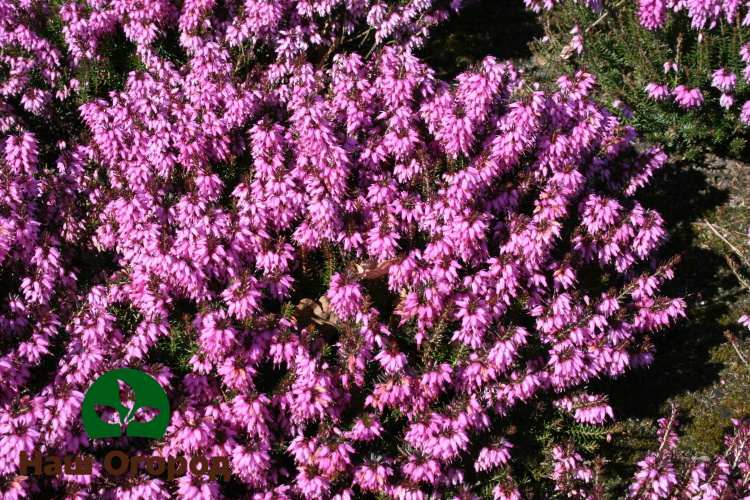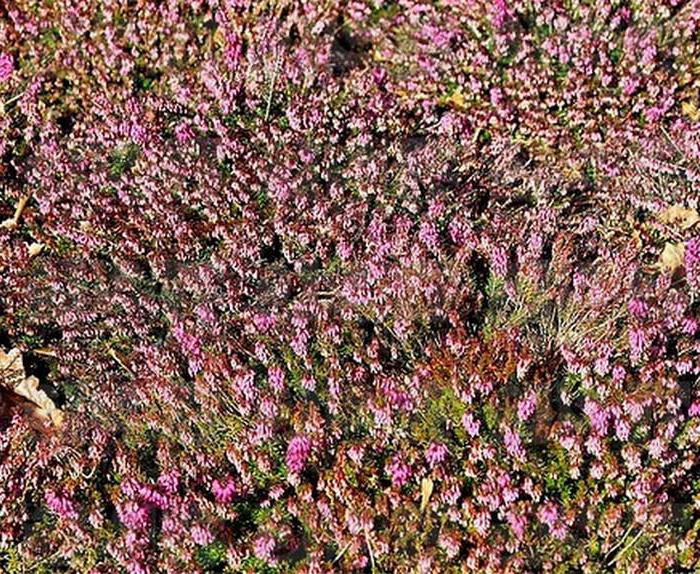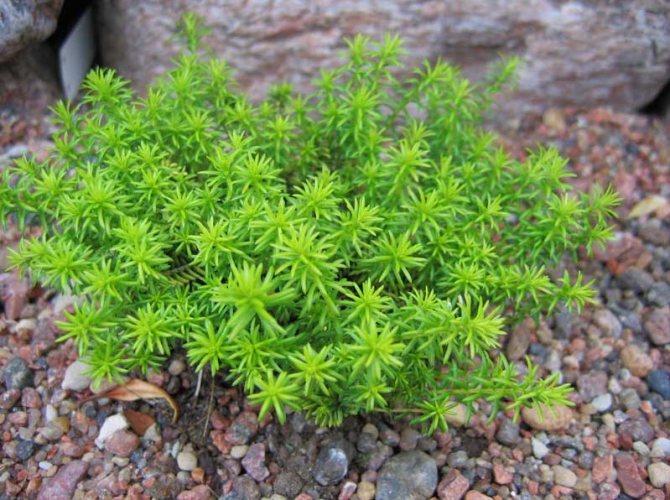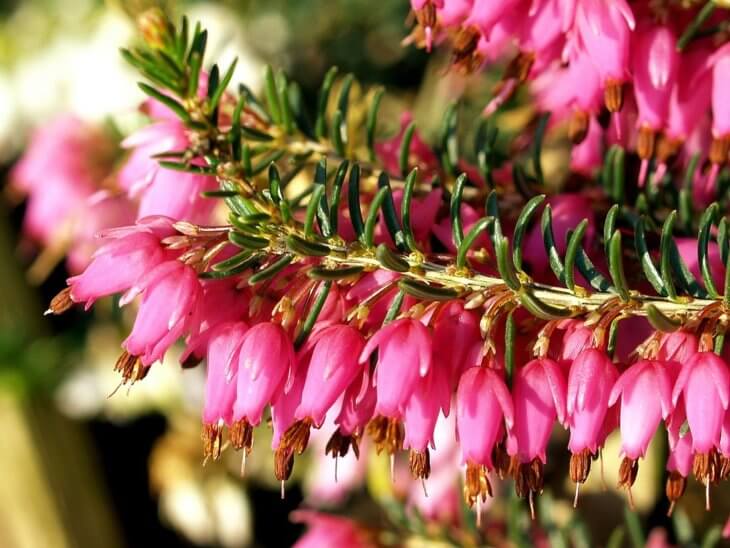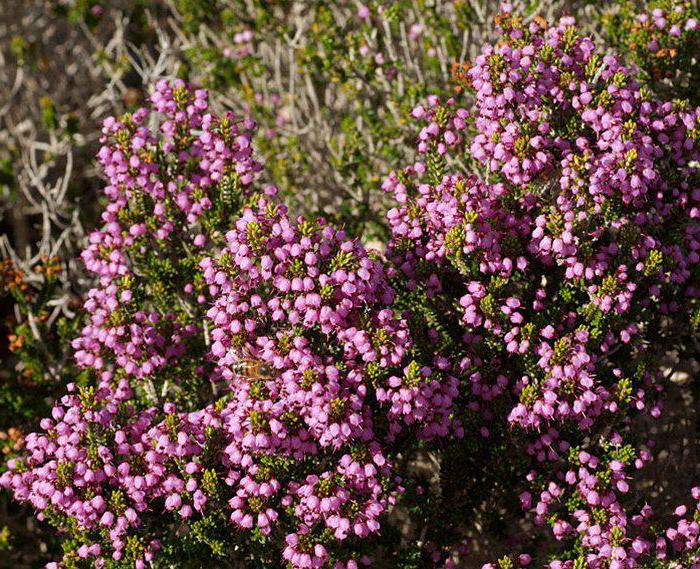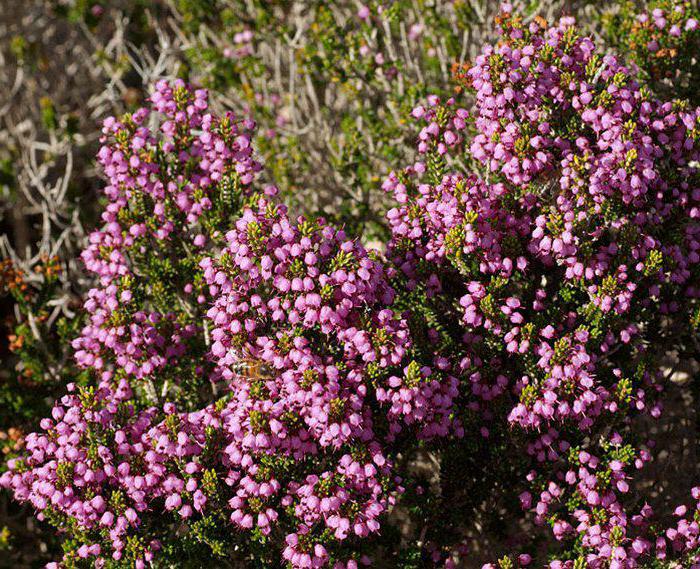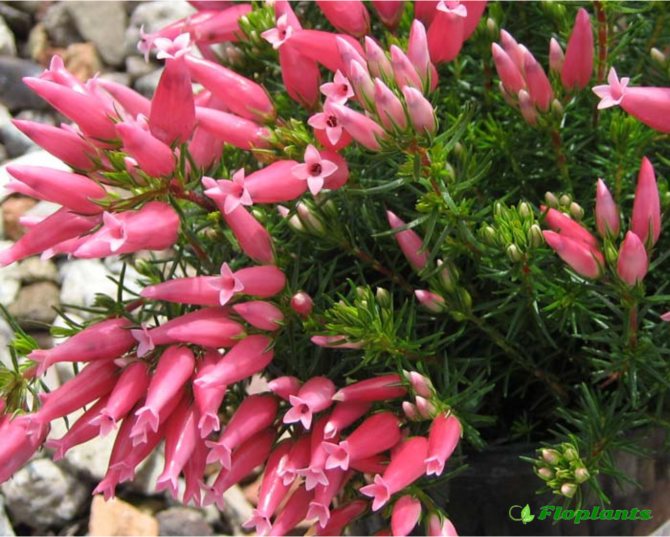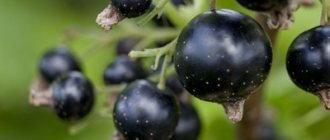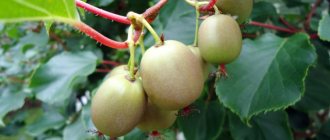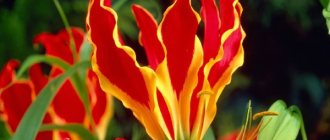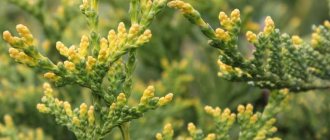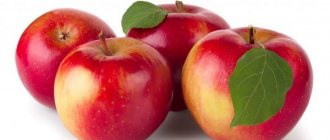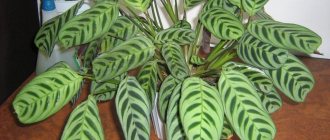One of the notable signs of autumn is the appearance of flowering bushes of multi-colored heather in almost every garden center and large supermarket. These miniature "bouquets", densely covered with tiny beaded flowers, are so adorable that they are hard to resist. In the West, heathers are often purchased as living autumn decorations, without thinking about their future fate. But if you plan to make heather or Erica very similar to it a full-fledged garden dweller, then the information presented in our article will probably come in handy.
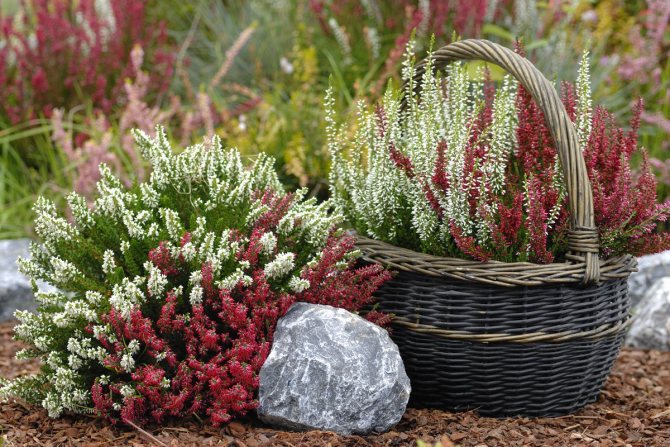
Heather or Erica - which to choose?
Popular in the Moscow region species and varieties
Erica herbal (ruddy). A dwarf evergreen shrub that forms a lush cushion of delicate greenery. Reaches 20 - 40 cm in height, up to half a meter in width. The shoots are tough, the needles are small, and when the weather gets cold they acquire a bronze color. Abundant flowering occurs in April - May. The flowers are small, arranged in a one-sided raceme, pink, red or white. Blooming Erica exudes a pleasant honey scent. It grows very slowly. Winter hardy. Varieties:
- Aurea is a variety with yellow-colored foliage and pale pink flowers;
- Challenger - with bright crimson flowers;
- Gold star - the foliage has a golden hue, the flowers are white;
- Isabel - snow-white bloom;
- Rosalie - pink flowers;
- Rubra - pink inflorescences with lilac tint;
- The Snow Queen is a variety with white flowers;
- Winter beauty - flowers of a rich pink hue;
- Winter ruby - the flowers are bright red.
Erica is graceful. A bush, half a meter high, pyramidal in shape. Leaves are linear, up to 4 mm, light green. The flowers are bright red, appear on the plant in October and bloom all winter. This variety is grown as a houseplant.
Erica cruciferous (four-dimensional). Lush shrub with a height of 40 - 50 cm. Needle foliage, gray-green color. Blooms in mid - late summer with red or pink flowers. Varieties:
- Ardi - flowers are dark pink with a lilac tint;
- Pink shine - pink-purple flowers;
- Silver bell - white flowers with a silvery sheen;
- Pink star - pink bloom.
Erica darlenskaya. Evergreen, spreading shrub up to 50 cm high. It grows quickly and is distinguished by abundant flowering of pink or purple flowers. Varieties:
- Flattened silver - a variety with dark green foliage and white flowers;
- Darley Dale - profuse lilac-pink bloom;
- The setting is purple flowers with a pink tint.
Erica is pink. Winter-hardy species, reaching a height of 50 cm. Grows quickly, blooms pink.
Which heather should you choose for your garden?
More often than not, heather turns out to be a spontaneous purchase in the supermarket, where we go there for completely different purposes. In this case, it is impossible to guarantee that the heather will take root in your garden. After all, this culture has a wide range of winter hardiness (from 4 to 6 zones), which varies depending on the variety.
Heathers brought from Europe for sale as temporary autumn decorations usually bear only the Latin name of the genus 'Calluna' (heather) on the label. In this case, it is not possible to determine which species or variety a particular plant belongs to.
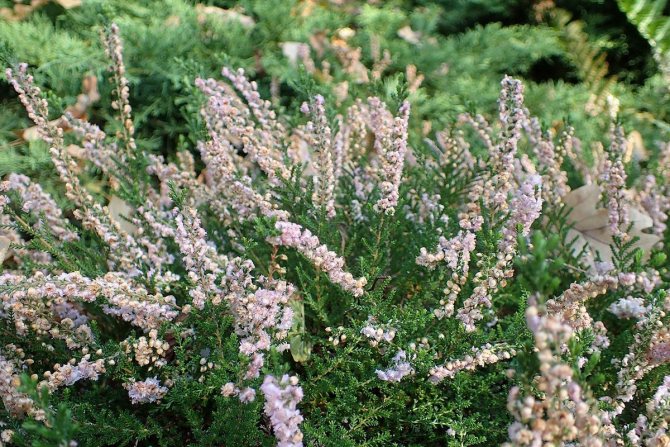

Common heather "Radnor" (Calluna vulgaris ‘Radnor’).
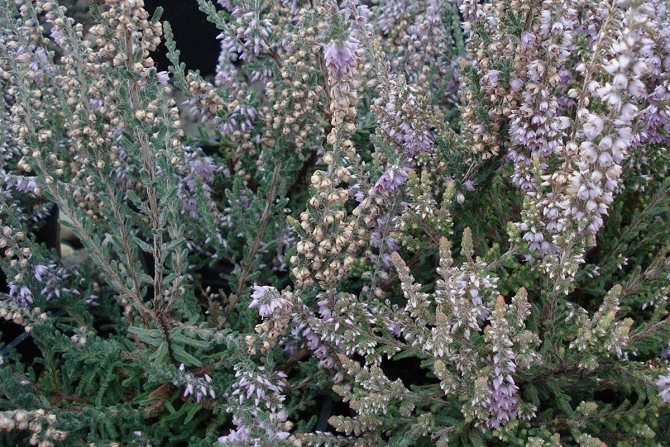

Common heather "Silver Knight" (Calluna vulgaris ‘Silver Knight’). <>
As a rule, low-winter varieties are used for sale in this way, which can survive the winter only under serious cover, or even die altogether, even if all measures to protect against frost were taken correctly. But perhaps you are really lucky, and the heather bought in the supermarket will be quite winter-hardy and will take root in your garden. But it's still a big lottery.
Remember: The heathers on supermarket counters are mostly geared towards florists and decorators rather than gardeners. To find truly high-quality planting material of hardy varieties, it is better to contact the nursery or explore the range of proven online stores.
The most common varieties of heather with a high level of winter hardiness (zone 4): "Radnor", "Dark Beauty", ‘Silver Knight’, 'Fritz Kircher', "Athena".
Heather has one thing in common with conifers, which makes the choice of planting material difficult. The dead heather, like a dried flower, does not shed scales and flowers from the stems for a long time. Before you buy heather, you need to check the flexibility of the branches and find out how tightly the scales sit on the stems (in a dead or severely weakened plant, they will easily crumble).
Many varieties of heather are distinguished by interesting color scales, which can be golden or reddish, so the unusual color is most often not a consequence of disease or death of the plant.
If possible, it is better to buy and plant heathers at the beginning of summer in a non-flowering state in order to give them time to root well and adapt in a new place, but the autumn planting of seedlings of winter-hardy varieties with a closed root system is also possible.
Heathers and eriks are acid-loving crops, and if the soil in your garden is not acidic, then they are planted in special soil (sour peat with the addition of coniferous litter and garden soil, or ready-made soil for azaleas). The place should be sunny or slightly shady.
In favorable conditions, over time, heathers grow, but in order to achieve the maximum decorative effect, it is better to initially plant them in groups, acquiring not one seedling, but several specimens of the same color.


Erica carnea ‘Winter Beauty’. <>
Reproduction
Erica can be propagated by seeds and cuttings. Hybrid varieties are propagated by cuttings that do not transmit their qualities through seeds. Cuttings are cut from the mother bush in late summer (August). The twigs are rooted in pots or plastic bottles in a sandy-peat mixture. A bag is put on the pots to maintain high humidity. The plantings are regularly aired, watered and sprayed. For the winter, the plants are brought into the room. They are planted in the ground in spring, when warm weather sets in.
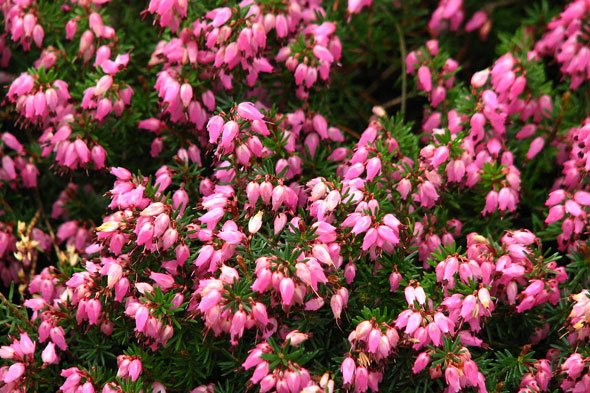

Erica seeds are grown through seedlings. The seeds are spread over the surface of a moistened substrate consisting of peat and sand. Seedlings will appear within a month. Seedling care consists in providing a temperature of +16 degrees, careful watering through the pan. When the seedlings grow to a height of 10 cm, they are dived into separate pots. Plants are planted in open ground the next year.
general information
Erica is a member of the Heather family. About 700 varieties of the genus Erica are native to the southern part of Africa. Others in the wild can be found in Turkey, the Mediterranean countries, as well as in the Caucasus and the island of Madagascar.
The British were the first to grow such a plant in the middle of the 18th century. One century later, breeders in Holland and Belgium began breeding Erica, as well as work on the development of new varietal forms and hybrids. The flower was brought to the CIS countries in 1994 from Germany.
Today, numerous varieties of this plant are grown both outdoors and indoors. Pots with decorative bushes are used to decorate rooms, window sills, balconies and loggias.
Description of the plant


Erica with her appearance and structure is very similar to heather. Novice growers often confuse these plants or believe that these are different names for the same flower. However, if you look closely at the bushes, you will notice some differences. For example, in Erica, the leaves are needle-like, located on the shoots at right angles, while in heather they are scaly and lowered to the stems.
Erica looks like an evergreen shrub with narrow leaves up to 1 centimeter in length, similar to needles. During the flowering period, the plants are covered with a large number of small bell-shaped flowers; after wilting, they retain their color and do not lose their decorative appearance for a long time. Inflorescences can be colored from white and milky to dark red and purple. In some varieties, they gather at the tops of the shoots and form tassels, while in others they hide in the axils of the leaves along the entire length of the stems.
Erica seeds are very small in size. They have the ability, being in the soil, to maintain germination for 10-20 years.
Description of the spirea flower, its main varieties and varieties
Site selection and soil preparation
Erica is a light-loving shrub that does not tolerate direct sunlight. When grown at home, it is placed on the eastern window sills. In the garden, slopes facing east or west are suitable. You can plant shrubs under trees so that their crown shades planting at midday.
Erica's branches are fragile, so the plant is planted in places protected from the wind.
The shrub grows in well-drained, nutrient-rich soil. Stagnation of moisture at the roots is destructive. A good substrate composition should include turf, humus, sand and peat. The acidity of the soil is different for different species. For example, Erica Darlinska grows only in acidic soil, and ruddy soil needs neutral.
In the garden, the shrub is planted only in spring, when the soil warmed up to at least +10 degrees. In the middle lane and the Moscow region, the plant is planted in May. Autumn planting is possible only in southern regions with warm winters, and even then there is a risk that the plant will not have time to take root.
Bush care
The main activities for the care of Erica are watering, loosening and mulching the soil, weeding from weeds, feeding and light pruning. In addition, the bushes growing in the garden need shelter for the winter.
Watering and loosening
Like other conifers, Erica should be watered with soft water at room temperature. Do not allow strong waterlogging of the soil and moisture stagnation. After planting, as well as during hot and dry periods, the shrub will have to be watered more often and abundantly.
Many growers in the evening spray the ground in the trunk circle from a spray bottle. This procedure has a beneficial effect on the development and growth of the flower, and also provides it with the necessary level of moisture.
When loosening, it is worth remembering that the roots of erica are located close to the surface and do not tend deeper into the soil. This procedure should be carried out either if the soil is compacted, or when removing weeds. Timely mulching of the near-stem circle will allow you to abandon weeding and loosening, and will also provide the bushes with a favorable microclimate. Peat, tree bark, sawdust and wood chips are usually used as mulch.
Rhododendrons: planting, growing and care in the Moscow region
Top dressing and pruning
It is necessary to apply top dressing to the soil only in the spring - once a year. For these purposes, it is better not to use organic fertilizers. Complex mineral products are well suited, for example, "Kemira universal" (30 grams per 1 sq.meter flower bed). Also in garden stores you can buy ready-made complexes for azaleas and rhododendrons. Erica will love them too.
It is worth remembering that when watering the bushes with a solution of dressings, it is important to avoid getting liquid on the shoots and foliage.
Erica pruning rules:
- Formative pruning of plants begins only 4 years after planting.
- The procedure is carried out before or after the flowering period.
- The crown is cut very carefully, below the inflorescences, without cutting off the lignified parts of the branches.
Correctly executed pruning gives the bushes a well-groomed and decorative look. Also, removing old stems stimulates the emergence of young shoots. Pruning each year encourages plants to form more flower buds.
Diseases and pests
Erica is rarely attacked by insect pests, but she can be affected by viral and fungal diseases. The most terrible misfortune for this plant is gray rot. Its appearance is provoked by high humidity, for example, stagnant water after rain or melting snow. The first sign of the disease is a gray coating covering foliage and shoots. To prevent the development of rot, the bushes are treated with drugs such as Topaz and Fundazol. As a prophylaxis, as well as at a deep stage of the disease, a solution of copper sulfate is used (10 grams per 1 liter of water).
Landing
Planting holes are prepared with a depth of 20 - 25 cm. Sand is poured at the bottom, in a layer of 2 - 3 cm. If the soil is clayey and wet, the drainage layer is increased, and crushed stone or expanded clay is added to the sand. Next, the hole is filled with fertile soil mixed with peat and sand. The distance between Erica bushes is 40 - 60 cm.
The seedling, 2 - 3 hours before planting, is kept in water, with the addition of a root formation stimulant (Kornevin, Heteroauxin). After which it is placed in a hole and covered with earth, after having straightened the roots and watered abundantly.
Erica - home care
If you grow Erica indoors, it is advisable to take her out to the balcony or loggia more often. The plant is very fond of good light, and also needs fresh air. Pruning is an important prerequisite for caring for Erica. Shoots are pinched or pruned, not only to stimulate the growth and bushiness of Erica, but also to give the bush a decorative, neat shape. From time to time, faded "bells" are removed from the plant by shaking off.
Video - Erica pink, evergreen low shrub.
Watering Erica is rarely watered in winter. In the summer months, when the plant blooms profusely, and its shoots lengthen very quickly, you should ensure good regular watering. But it is impossible to allow stagnation of moisture in the soil.
Temperature Sudden jumps in temperature are detrimental to Erica. The plant is very thermophilic and does not tolerate drafts, cold winds. In winter, it is best to place it on the windowsills above the heating radiators, while ensuring sufficient humidity.
Top dressing Fertilize the plant very carefully. Organic matter for feeding is not suitable - it can "burn" the shoots and stems. It is best to use store-bought mineral formulations that are diluted less than recommended on the packaging. Fertilize the soil just before flowering.
Transfer Erika needs to be repotted at the end of each winter. At the same time, after removing the plant from the pot, it is placed in a jar or other vessel with water for 1-2 hours, after which it is planted in fresh peaty soil.


Erica ventricosa
Application in landscape design
Erica, thanks to her late flowering, is a real find for gardeners who create rock gardens, rockeries and flower beds. Landscape designers often use it as a ground cover. In addition, blooming Erica looks great both in mono compositions and in group plantings.


The plant in the garden creates a special microclimate that contributes to the development of other crops - heather, cereals, barberry, Japanese spirea. With such neighbors, Erica looks especially attractive.
For many years this plant has been a recognized decoration of the garden.
Where is the best place to put Erica
When choosing a place for Erica, it is necessary to take into account the fact that under natural conditions the shrub grows on well-drained and breathable soil, which means that similar conditions must be provided in home cultivation, because stagnant water in the root system can lead to flower diseases.
As for the place, the plant does not tolerate direct sunlight, therefore, it is better to choose a well-lit, but cool area.
Based on this, Erica will feel great on the east, or east-west window.
The soil should be acidic, with a pH of 3-4. The best soil for Erica is turf, peat and sand.
Growing Erica
From the very beginning of spring to late autumn, the amazing plant Erica, belonging to the heather family, pleases with its exuberant long flowering, a variety of color palette. Originally from South Africa, it has thoroughly won the hearts of gardeners around the world.
Description
Most erica species are evergreen shrubs that are very similar to heather. It is distinguished by narrow needle-like leaves up to 1 cm long, similar to needles, which grow at right angles to the shoot.
During the flowering period, Erica is covered with numerous small flowers, reminiscent of elongated drooping bells. They are collected in large one-sided brushes and come in a wide variety of shades - from white to deep purple. After flowering, the color remains for a long time.
The fruits are capsules with very small seeds that remain viable for several years.
Then, already in Belgium and Holland, almost a hundred years later, breeding work began, thanks to which many hybrids appeared.
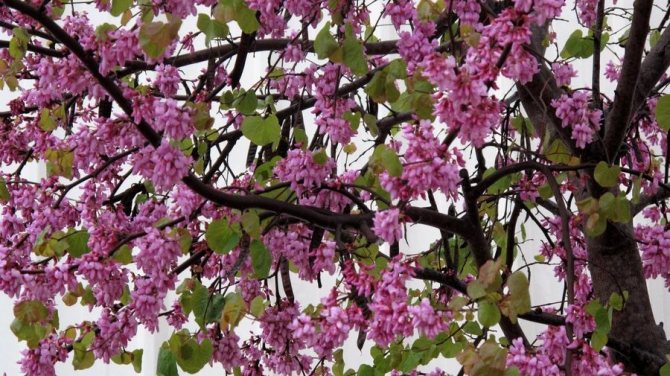

Today, the Erica plant, a description of some of the species of which is given below, is grown both outdoors and in pots, decorating windowsills and terraces. It is unpretentious and does not need special care.
Types of Erica
This plant is distinguished by a wide variety of species. Among them there are several gardeners that are distinguished by an increased interest in them:
- The very first to bloom is Erika herbaceous, or ruddy - already in April it is covered with pink or reddish bells. The height of this shrub is from 30 to 50 cm. Its outstretched stems are capable, under favorable conditions, of forming a pillow up to half a meter in diameter on the soil surface.
- Erica graceful is cultivated mainly as a pot plant. Flowering begins in November and lasts for several months. There are several varieties of Erika graceful - with white, pink and reddish flowers.
- Erica Darlenskaya plant is a hybrid created by English breeder Darley Dale in the early twentieth century. Today it is widespread in Russia. Differs in high winter hardiness and abundant long flowering. There are more than 20 varieties of this species, the tallest of which reaches a height of 50 cm.
- The Erica pink plant is one of the smallest species. Its height rarely exceeds 20 cm. Dark red flowers appear in April.
All species of this plant are propagated by seed or cuttings. The seedlings can be transplanted to a permanent place no earlier than after 1.5–2 years.
This method is rather laborious and is recommended mainly for planting natural types of erica. Seeds are sown on prepared soil, consisting of coniferous, heather earth and sand (in a ratio of 1: 2: 1, respectively) and covered with glass or plastic wrap.
In this case, the temperature must be at least 18 ⁰С. Every day the soil with seeds is sprayed with warm water. The seed germination process is quite long and takes at least 1 month. As soon as the shoots appear and grow a little, they are dived and gradually accustomed to sunlight.
In order to get stronger, the seedlings will need another 2 months.
Plants grown in this way begin to bloom much earlier than those planted with seeds. Planting material is harvested in the fall, cutting off the tops of lignified shoots.
Pre-soaked in a growth stimulator, the cuttings are planted in a substrate consisting of a mixture of peat and sand. Before that, it is recommended to spray them with water. The soil should be sufficiently moist and loose, and the temperature should be 18–20 ⁰С.
Planting should be protected from direct sunlight.
After about 3 months, the cuttings take root. Now you can start gradually exposing them to the sun and fresh air. This hardening period lasts for a month. Only then can the young Eric's plant be planted in the garden.
It should be noted that in nature, plants grow only on air-permeable soils. Without providing good drainage, they simply will not develop fully. The plant does not tolerate stagnant water.
When choosing a landing site, avoid areas where there is an accumulation of melted snow. In order to maintain the bright color of the leaves and flowers, Erica needs a sufficient amount of sun. Do not plant it in shaded and windy areas.
Erica is a plant, planting and caring for which is not difficult if the place for it is chosen correctly.
Care features
Erica prefers slightly acidic or neutral soil. If you add a little river sand to it, then the plants will feel great for many years. Growing erica is within the power of even a novice gardener. All this plant needs is to ensure timely watering, feeding and pruning the shoots when flowering ends.
Erica is a plant that home care also includes preparing for the winter. Before the onset of the first frosts, it is necessary to moisten and mulch the soil, and cover the plantations with dry foliage or spruce branches. Mulch will not only provide the plant with a good wintering, but also enrich the soil with useful substances.
Top dressing
Mineral fertilizers are usually applied during planting, before flowering and after pruning. They are scattered on the surface of the soil, lifting the branches of the plant to prevent them from being burned. Fertilizers can be added to the water used for irrigation. When loosening the soil, a layer of mulch is poured on top (up to 5 cm thick). Pine bark, wood chips and peat are used as it.
Although the Erica plant is a drought-tolerant crop, caring for it necessarily includes regular watering. It is necessary to ensure that the soil is always moist. The water should be soft and of a certain temperature.
When the soil dries up, watering is required especially plentiful. The potted plant can be completely submerged in water for half an hour. Eric's plant is very sensitive to air humidity. Therefore, it is recommended to spray the ground part periodically.
Only the green part of the shoot, which has leaves, should be removed. Experts recommend asymmetrical pruning - it allows you to preserve the natural appearance of the plant and give a more attractive appearance.
Diseases and pests
The most common diseases inherent in this plant are caused by fungal and viral infections. Among them, gray rot is most common. The reason for its development is usually high humidity.
The first signs of the disease are gray bloom, leaf fall and the death of young shoots. Today there are enough different antifungal insecticides that help to cope with gray mold: "Fendazol", "Topaz".


For very serious rot injuries, spraying with a 1% solution of copper sulfate is recommended. Treatment of diseased plants is carried out twice with an interval of 5-10 days.
For prophylactic purposes, spraying is carried out in the autumn-spring periods, using the above-mentioned preparations for this.
As for insect pests, their plant is practically not interested in Eric. Occasionally, you can find bugs and ticks on it. Treatment of plant stems and leaves with an alcohol solution, which is applied with a brush, is effective against them. Then the areas affected by pests are additionally treated with special agents called "Actellik" and "Fitoverm".
Erica, thanks to her late flowering, is a real find for gardeners who create rock gardens, rockeries and flower beds. Landscape designers often use it as a ground cover.
In addition, blooming Erica looks great both in mono compositions and in group plantings. The plant in the garden creates a special microclimate that promotes the development of other crops - heather, cereals, barberry, Japanese spirea.
With such neighbors, Erica looks especially attractive.
For many years this plant has been a recognized decoration of the garden.
Growing Erica is a simple process, but everything needs to be done in an integrated manner, observing the rules of planting, watering, feeding and wintering the plant. We will talk about this in more detail later.


It is best to plant Erica with the onset of the first warm days, when the temperature outside stabilizes around 10 ° C. This is the main condition, the observance of which will help the plant to grow stronger before winter.
If you plant Erica in the fall, then the shoots will freeze, or, in the worst case, the plant will die. Usually, when planting, soil remains on the roots, therefore, before planting, it is necessary to moisten them well.
Reproduction of Erica
Erika can be propagated vegetatively, using cuttings, or using seeds when propagating natural varieties.
Important! Hybrid varieties are best propagated vegetatively, since during seed propagation, they may not preserve the varietal characteristics of the "parent" plants. Propagation by cuttings is easy. The best period for this procedure is the end of summer.
The cut stalk must be planted in a mixture of peat and sand and create a "wig effect" by covering the container with glass or film. In this state, the cuttings stand until spring. From time to time, the film must be removed and "aired" the planted plants, as well as moisten the ground from a spray bottle.


By the spring, layers will appear that need to be dug in. When the root system is sufficiently developed, the plants can be planted in pots.
Seed reproduction is as follows: Erica seeds are sown on the surface of a soil mixture consisting of sand, coniferous soil and heather soil (they do not need to be deepened much). The sown seeds must be placed under glass or film and wait for the first shoots to appear, usually this process takes about a month.
The optimum temperature is 18 ° C… 20 ° C.
Did you know? The sown seeds should not be watered, and the process of moistening the soil should be carried out carefully, by spraying the container. When the seedlings reach a size of 8-10 cm, they must be dived into the pots and protected from direct sunlight. For the winter, young plants should be placed in a cool place with a temperature of 10 ° C ... 11 ° C.
Erica darleyensis. Erica species
- Erica herbal (Erica carnea). Often this plant can be found under the name of erika ruddy. It is an evergreen shrub with a spreading crown, reaching 30-50 cm in height. It is also popularly called "winter heather". If this variety is planted in the southern regions, then flowering can begin in the winter months, so many growers prefer to grow it in central Russia because of its winter hardiness.Up to 200 varieties have been created on the basis of this plant. It can be grown almost like a ground cover, since, growing, the shoots form a living carpet. Used for the construction of alpine slides or heather gardens. The branches of the shrub are open, and the shoots are bare, covered with dark gray bark. The color of the leaves is bright green, they have a linear elongated shape, are arranged whorly in 4 pieces. Their size reaches a centimeter. The leaves that are at the bottom of the bush and are quite old with the arrival of autumn turn reddish. It blooms with pink-red buds, sometimes whitish colors are found. Their shape is bell-shaped, drooping. The arrangement of flowers in the axils of the leaf plates. There are collected 2–4 pieces, of which the terminal inflorescences-brushes, one-sided, are formed. The flowering process stretches from mid-late spring (directly depends on the place of growth) to July. In areas further south, it begins to open flowers in March.
- Erica four-dimensional (Erica tetralix). She is sometimes called Erika crucifix. This species is also able to endure winters in central Russia. The plant has a shrub growth with compact size. The stems are pulled straight up to a height of 50–70 cm in their natural environment, in indoor conditions from 15 cm to half a meter in height with a diameter of 50 cm. The leaves are painted in a gray-green color, a very decorative variety. The leaf plates are collected in whorls of 4 units, and have felt pubescence. The flowering process stretches from summer to autumn months. The flowers can be white, pale pink or red in color.
- Erica darleyensis. The plant is a hybrid of Erica herbal and Erica Erigena, which has been cultivated in England since the beginning of the 20th century. The first variety gave her the duration of flowering (from November to May), and the second the abundance of buds. This Erica is often sold in Western Europe as a Christmas plant. The height of the bush approaches the meter mark in natural nature, the variety is not as winter-hardy as the previous species. The crown is spherical and dense, the height starts from 40 cm with a diameter of up to half a meter. Higher growth rate than erika ruddy. The color of the buds varies from white to deep crimson tones.
- Erica arborea. The plant has the shape of a tree, unlike other varieties and prefers to settle on dry and rocky surfaces in the wastelands of the Mediterranean lands. The flowers of the variety are whitish, with anthers of a red-brown color, their shape is bell-shaped, drooping, racemose inflorescences are collected from them. They have a strong fragrant aroma.
- Erica spiculifolia. A semi-shrub with a spreading crown up to 25 cm in height. The color of the deciduous mass is dark green. The flowering process occurs in the months of June and July. The color of the buds is pale pinkish.
- Erica gray (Erica cinerea). A sprawling plant with a shrubby form of growth, reaching 20-50 cm in height. The color of the leaves is gray-green. The color of the buds is pinkish or whitish.
Possible difficulties
Sometimes the plant is affected by various diseases. Of the fungal misfortunes, one can distinguish:
- Gray rot - with it, the branches are covered with a gray tint, the bush begins to shed its foliage and some branches die off. This happens in high humidity.
- Powdery mildew - a white bloom appears on the bush, and young twigs die off.
- Rust - brownish-red spots form on foliage.
If diseases caused by a fungus appear on the bush, then it should be treated with fungicidal agents according to the instructions. Also, fungicides help with the worm or spider mite.
If the cause of the lesion is a viral disease, then the flowers and shoots are subject to deformation, and the color of the foliage and shoots may also change. In this case, it is no longer possible to help the plant, therefore, in order not to infect the rest of the plantings, the diseased plant should be dug up and burned.
Erica is most commonly used in horticultural floriculture, but some of her species can also be grown in rooms. The plant is a shrub with delicate, needle-like, light green leaves. Belongs to the Heather family. When optimal conditions are created, Erica blooms very profusely with elongated "bells" of different colors. The homeland of a flowering shrub is Africa.
How to care for Erica in the garden and at home
Growing Erica is not difficult. It will take the implementation of standard actions: watering, fertilizing, pruning, preparing for the winter period.
Temperature regime
It is necessary to provide a suitable temperature regime (naturally, when growing Erica in room conditions). The air temperature should be kept between 18-20 ° C, and during the flowering period should be kept in the range of 7-8 ° C. If the temperatures are higher, you need to take care of the air humidity. Spray the plant several times a week, periodically place it on a pallet with wet moss, expanded clay, pebbles.
How to water
In the open field in dry hot weather, use sprinkling. For watering and spraying, use softened water at room temperature.
In the summer, water abundantly and often, but do not overmoisten the soil. If the earthen lump in the pot is dry, place the container in a bucket of water for 40-50 minutes. Provide moderate watering in winter.
How to feed
To maintain the strength of the plant, it is enough to feed it once a season. It is not recommended to use organic matter as a fertilizer, especially fresh.
A suitable food for Erica is a complex mineral fertilizer (for example, Kemira-universal; apply 20-30 g per 1 m²) or fertilizers for rhododendrons, azaleas (reduce the dosage indicated on the package). Top dressing is applied with water for irrigation. In order not to cause burns to the plant, try to avoid getting liquid on the leaves.
How to trim
In the first two years of growth, the plant cannot be pruned. In the future, you can carry out a light formative pruning of the bush. Also remove dry, damaged and diseased shoots, try not to touch old wood. Prune in early spring or after flowering ends. Also remove withered inflorescences. Use pruning shears, and treat the cuts with garden pitch or crushed charcoal.
Wintering
If the plant is in a pot at home, then it can winter on the same windowsill. Just water Erica less, and do not carry out any grooming procedures before the growing season.
If the plant is in the garden, then some of its varieties will require additional winter shelter. If the climate is very harsh, then it is better to cover all specimens of erica, regardless of the variety: this way there will be more chances that the plant will come to life and grow in spring.
In order to cover, the root circle is mulched with a layer (10 cm) of dry foliage or peat bog. The part of the plant that remains above the ground is covered with spruce branches. In the spring, as soon as the sun starts to warm up steadily, the cover with spruce branches is removed and the mulching layer is raked off.
Diseases and pests
Most often, the plant suffers from fungal diseases.
Gray rot develops with increased air and soil humidity. This happens with excessive watering, flooding with melt water, or belated removal of the shelter in the spring. A gray bloom appears on the branches, the shoots begin to partially die off, the leaf platinum crumbles. treatment with an antifungal fungicidal drug (Fundazol, Topaz) will be required. In case of significant damage, treat the bush with Bordeaux liquid or 1% solution of copper sulfate, treat it 2-3 times with a frequency of 5-10 days. For prevention purposes, treatment with similar drugs is carried out in early spring (after removing the shelter) and in autumn.
Possible defeat powdery mildew: young twigs become whitish and die off. The appearance of reddish-brown stains is a symptom of rust.To save from these diseases, fungicide treatment will be required.
If the buds and shoots acquire a strange shade, they are deformed - this is virus attack... It is impossible to cure the plant. Dig up diseased plants and burn them so as not to infect others.
You may encounter a problem such as falling leaves... The reason is a lack of moisture, it is necessary to water well and adjust the humidification mode.
Among insect pests spider mites and mealybugs can cause trouble. When growing a bush in indoor conditions, moisten a cotton swab with an alcohol solution and remove traces of insect activity (whitish cobwebs or similar lumps of cotton wool). In any case, an insecticide treatment will be required. As a preventive measure, spray the plantings with soapy water, promptly remove fallen leaves from under the bush.
Eric's plant is a shelter for the winter. Flowering and species
Erika herbaceous or ruddy (Eríca cárnea) and Darleys (Erica x darleyensis) bloom earlier than anyone else in late winter and early spring. Flowering continues until the end of April. In the second half of June and until the end of August, the flowering time of the four-dimensional erica (Erica tetralix), which prefers moist and ash soil (Erica cinerea), begins. Erica vagans blooms in August-September with pink, white or cream flowers, can reach 75 cm in height.
Erica Darleys is a hybrid obtained in the early twentieth century by the English breeder Darley Dale by crossing Erica ruddy. The popular variety "Kramers mouth" grows up to 50 cm in height and is one of the tallest varieties of this species. Grows rapidly, creating large clumps.
Small, green, needle-like leaves are densely packed around the shoot. From late February - early March, as soon as the frosts subsided and the snow melted, ruby-red flowers appear on the raised stems on the bushes. It blooms at relatively low temperatures, so bloom can last until May. Shelter is required during winter.
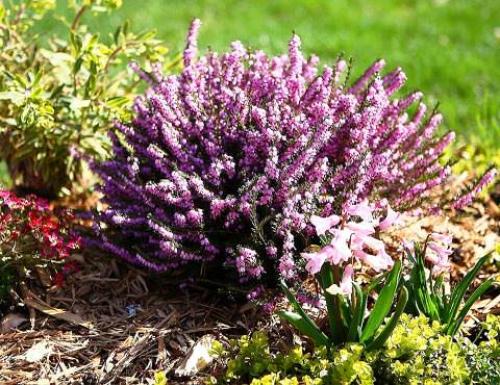

Erica herbaceous is the most popular in the culture. Very hardy, tolerant of most soils and the most frost resistant of all cultivated species. It is a low-growing (10-25 cm) spreading shrub. Thanks to selection, more than 100 cultivars and hybrid forms of high decorativeness were obtained. Some famous varieties: Golden Star, Ice Princess, Myretoun Ruby, Natalie, Pink Spangle, Sunshine Ramble, Jenny Porter, etc.
Erica ash is cultivated in a wide range of colors. The height of the bushes is 15-60 cm. It hibernates under cover. Decorative varieties: "C.D. Eason ”,“ Pink Ice ”,“ Velvet Night ”.

